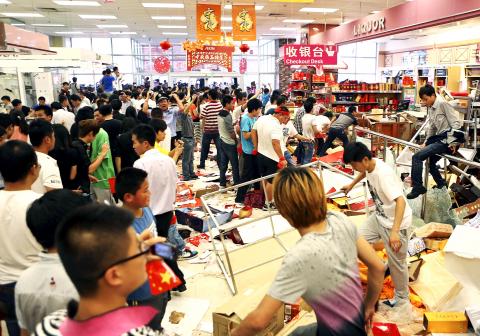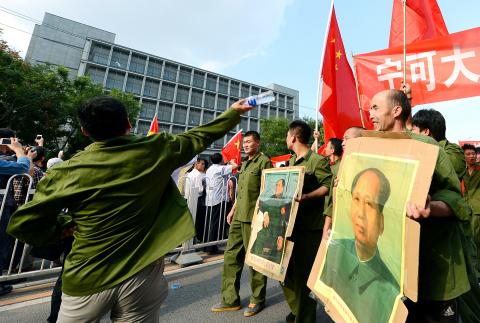Angry demonstrators attempted to storm the Japanese embassy in Beijing yesterday, state media said, as tens of thousands of people across China protested against Japan over a growing territorial dispute.
Riot police armed with batons and shields struggled to contain the swelling crowd outside the embassy, where witnesses said at least 2,000 people had gathered, some of them throwing stones and plastic bottles at the building.
A mob attempted to break into the embassy compound, but were stopped by armed police, Xinhua news agency said. It estimated the crowd at several thousand at its peak.

Photo: Reuters
Meanwhile, there were online reports that protests were staged in at least a dozen cities across China, with Japanese-built cars and Japanese restaurants being attacked by angry crowds.
Japanese media estimated 40,000 people took part in the protests nationwide.
On China’s Sina Weibo (新浪微博), a microblog similar to Twitter, images were posted of protests in Chongqing and Kunming.

Photo: AFP
Rallies were reported in several other places, including Nanjing, Xian and Taiyuan.
Much of the information about the protests posted online appeared to have been removed by the afternoon by China’s army of Internet censors — suggesting that Beijing is aiming to stop the row from spiraling further out of control.
The protests also did not feature on regular news bulletins on the state-run China Central Television.
The rumbling territorial dispute reached a new level this week, when Japan announced that it had bought islands in the East China Sea that it administers and calls the Senkaku Islands. The islands are also claimed by Taiwan, where they are called the Diaoyutai Islands (釣魚台), and China, where they are called the Diaoyu Islands.
Six Chinese ships sailed into waters around the archipelago on Friday, with Beijing saying they were there for “law enforcement,” leading Tokyo to summon the Chinese ambassador to protest what it insisted was a territorial incursion.
In the Chinese capital, where there have been large anti-Japan demonstrations for the past few days, roads were cordoned off and a helicopter hovered overhead, monitoring the embassy protest.
Nearby Japanese restaurants, which were all closed, appeared not to have been targeted by the angry crowds, but some protesters had draped Chinese flags over them.
Police monitored other demonstrations across China.
In Shanghai, police threw a security ring around the Japanese consulate, but allowed groups of protesters to approach the compound for short periods.
Scores waved Chinese flags, chanted slogans such as “Little Japanese” and held up signs insisting the islands were Chinese.
Police confiscated their signs and banners at the conclusion of the protest.
China and Japan are Asia’s two biggest economies with close trade and business ties. However, the relationship is often tense due to the territorial dispute and Chinese resentment over historical issues.
A Japanese diplomat said on Friday that Tokyo had issued a safety warning to its citizens in China after six “serious” cases of assault and harassment, all in Shanghai.

The CIA has a message for Chinese government officials worried about their place in Chinese President Xi Jinping’s (習近平) government: Come work with us. The agency released two Mandarin-language videos on social media on Thursday inviting disgruntled officials to contact the CIA. The recruitment videos posted on YouTube and X racked up more than 5 million views combined in their first day. The outreach comes as CIA Director John Ratcliffe has vowed to boost the agency’s use of intelligence from human sources and its focus on China, which has recently targeted US officials with its own espionage operations. The videos are “aimed at

STEADFAST FRIEND: The bills encourage increased Taiwan-US engagement and address China’s distortion of UN Resolution 2758 to isolate Taiwan internationally The Presidential Office yesterday thanked the US House of Representatives for unanimously passing two Taiwan-related bills highlighting its solid support for Taiwan’s democracy and global participation, and for deepening bilateral relations. One of the bills, the Taiwan Assurance Implementation Act, requires the US Department of State to periodically review its guidelines for engagement with Taiwan, and report to the US Congress on the guidelines and plans to lift self-imposed limitations on US-Taiwan engagement. The other bill is the Taiwan International Solidarity Act, which clarifies that UN Resolution 2758 does not address the issue of the representation of Taiwan or its people in

US Indo-Pacific Commander Admiral Samuel Paparo on Friday expressed concern over the rate at which China is diversifying its military exercises, the Financial Times (FT) reported on Saturday. “The rates of change on the depth and breadth of their exercises is the one non-linear effect that I’ve seen in the last year that wakes me up at night or keeps me up at night,” Paparo was quoted by FT as saying while attending the annual Sedona Forum at the McCain Institute in Arizona. Paparo also expressed concern over the speed with which China was expanding its military. While the US

SHIFT: Taiwan’s better-than-expected first-quarter GDP and signs of weakness in the US have driven global capital back to emerging markets, the central bank head said The central bank yesterday blamed market speculation for the steep rise in the local currency, and urged exporters and financial institutions to stay calm and stop panic sell-offs to avoid hurting their own profitability. The nation’s top monetary policymaker said that it would step in, if necessary, to maintain order and stability in the foreign exchange market. The remarks came as the NT dollar yesterday closed up NT$0.919 to NT$30.145 against the US dollar in Taipei trading, after rising as high as NT$29.59 in intraday trading. The local currency has surged 5.85 percent against the greenback over the past two sessions, central